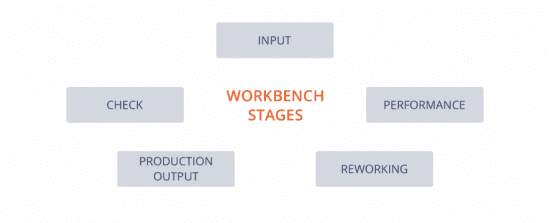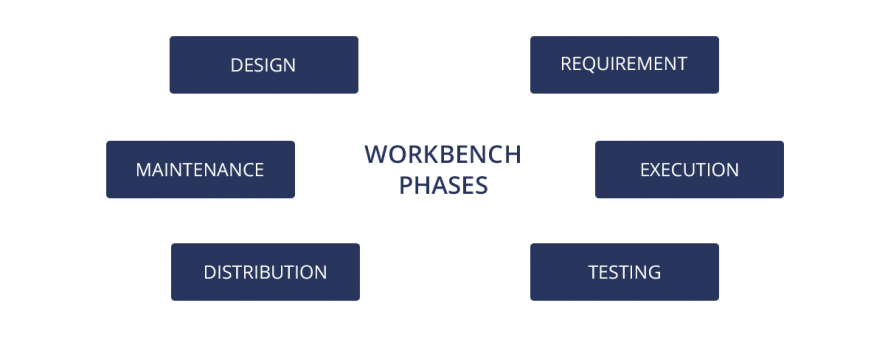Workbench Concept in Software Testing
by Nataliia Vasylyna | October 28, 2011 10:00 am
Note: This article was updated in June 2019.
Considering the variety of testing scenarios that depend on each specific product, the testers’ work has to be carefully planned and structured. One of the specific approaches for building a test strategy is called workbench concept. Let us reveal some more information for your review.
Workbench Concept: Goals and Stages
This is a method which aims to examine and verify the structure of testing performance[1] by detailed documenting. Workbench process has its common stages and steps which serve for different test assignments. The common stages of each workbench include:

Input. It is the initial workbench stage. Each certain assignment should contain its initial and outcome (input and output) requirements to know the available parameters and expected results. Each workbench has its specific inputs depending on the type of product under testing.
Performance. The priority aim of the entire testing is in the transformation of the initial parameters to outcome requirements and reach the prescribed results.
Check. It is an examination of output parameters after the performance phase to verify its accordance with the expected ones.
Production output. It is the final stage of a workbench in case the check confirmed the properly conducted performance.
Reworking. If the outcome parameters are not in compliance with the desired result, it is necessary to return to the performance phase and conduct it from the beginning.
Verification and Validation: Differences in Functions
The verification and validation are the main aims of the workbench concept, but it is important to know the difference between them to outline all the specific elements of each process clearly:
Verification
- Checks program, documents, and design.
- Reviews, desk-checking, walkthroughs, and inspection methods.
- Check of accordance with the specified requirements.
- Bug detection is performed on the cycle of early development[2].
- It precedes the validation.
Validation
- It is a process of testing and validating the real product.
- It uses non-functional testing[3], Black Box Testing, and White Box Testing.
- Checks whether the software is in compliance with customers’ expectations.
- It can detect bugs, which are missed by verification.
- It is performed when the verification is done.
We can conclude, that verification is conducted at the initial stage before validation and verifies the input requirements. The validation checks the examination performed by verification and detects the missed issues to make the real product closer to the definition of done.
Workbench Phases
Let’s look at the initial and outcome data from different angles, considering various phases:

Requirement phase
- the initial data should be collected from the customer to perform a test task;
- the customer’s requirements are included in the document to check its accordance with clients’ needs;
- the outcome data are received and codified in one document.
Design phase
- the initial data is in the requirement document;
- testers prepare the technical document and check if the design document is technically proper;
- testers check if the information about the requirements is transferred to the requirement document completely.
Execution phase
- it is the performance of the entire testing process;
- the initial data is contained in the technical document, and the performance means adjusting of code according to the documented technical requirements;
- the outcome data is the source code.
Testing phase
The initial parameters are contained in the source code, and the outcomes are formed after the test performance.
Distribution phase
The aim of this phase is to prepare the product which is ready for use. Initial data, in this case, is a code version given by customer with initial requirements and code after testing.
Maintenance phase
- input appears as the outcome of distribution;
- the outcome data forms a new release;
- each change in product requirements is subjected to regression testing to fulfill the customers’ requests.
Conclusion on Workbench in QA
The workbench concept serves to build and monitor the proper structure of testers’ work. It helps to divide assignments in each phase of testing and reach the customers’ expectations relying on initial data and transforming the product parameters into desirable ones.
Learn more from QATestLab
Related Posts:
- testing performance: https://qatestlab.com/approach/technologies/
- early development: https://blog.qatestlab.com/2019/04/16/trends-2019-qaops-in-software-testing/
- non-functional testing: https://qatestlab.com/services/
- The 2025 Cloudflare Outage: A Stress Test for SaaS Resilience: https://blog.qatestlab.com/2025/12/16/the-2025-cloudflare-outage-a-stress-test-for-saas-resilience/
- Automation, AI Testing, and Accessibility: Key Trends from VDS 2025: https://blog.qatestlab.com/2025/11/11/automation-ai-testing-and-accessibility-key-trends-from-vds-2025/
- VivaTech 2025: Wearable AI, Next-Gen Robotics, and Assistive Accessibility Devices: https://blog.qatestlab.com/2025/06/27/vivatech-2025-wearable-ai-next-gen-robotics-and-assistive-accessibility-devices/
Source URL: https://blog.qatestlab.com/2011/10/28/workbench-concept-in-software-testing/

